Is There a Dog That Is Blue Blue Dog

Blue dog breeds are quite rare and beautiful
By
Updated on the
The colour Blue is generally associated with tranquility and calmness, like the sky and the sea. Some owners who chose a dog for its blue colour might have had this thought in mind. Or, perhaps it's because of the dog's uniqueness.
There are several types of blue-coated dogs. Some appear to be a striking blue colour whereas others are more of a silver or grey shade. No matter which colour you choose, blue dogs are certainly eye-catchers and very impressive looking dogs.
What breed of dogs are blue?
The colour blue on a dog's coat is a true beauty and quite rare. Solid blue and blue colourways don't occur in all breeds. So, if you have decided that you would like a pet with a blue coat, we've compiled details of some of the most amazing blue breeds to help with your search.
1. Blue Heeler/ Australian Cattle dog

The Australian Cattle dog, also known as the Blue Heeler are loyal and excellent herders. They were named this way because they tend to nip at the heels of their livestock they are herding. At first, they can be a little shy with people but once you earn this dog's trust, you will have an amazing companion.
The Blue Heeler has blue dots usually on its legs and chest. The intensity of the blue depends on the size of the dots. However, the Blue Heeler can be either blue or red, it will depend on the dominant colour gene of its coat.
2. Kerry Blue Terrier dog
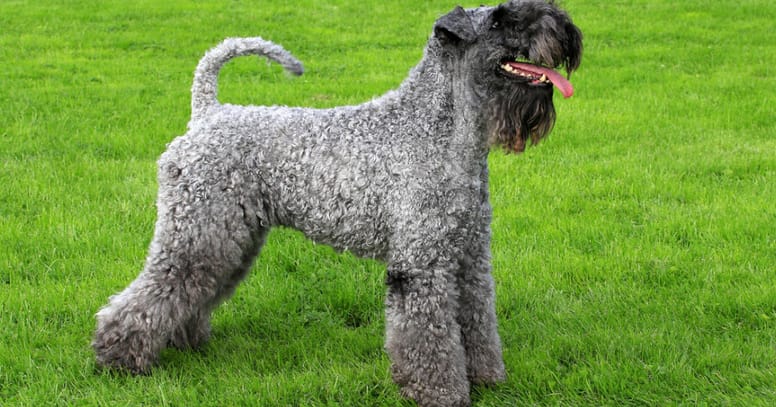
I think the name of the breed makes it obvious... the Kerry Blue Terrier's common coat colour is blue. In fact, they can have different shades of blue. Their physique is very similar to their cousin the Airedale.
The Kerry Blue Terrier pup was bred to hunt and herd, and as a result, they are very energetic and have a high prey drive. This pooch loves to interact with its owner, so if you like going out and exercising, you have find the perfect companion for your adventures.
3. Weimaraner
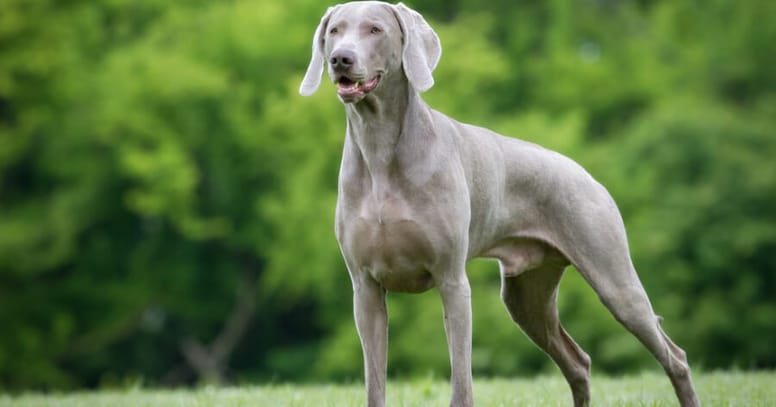
This stunning dog breed can just as easily appreciate a day out in the nature and enjoy a quiet day at home. Of course, you will need to make sure you provide enough exercise to your dog everyday. The Weimaraner is loyal, easy to train and healthy.
Known for their unique physique, this dog breed's coat colour is usually steely grey. However, it can happen that a black dilute gene is present and this produces a dark grey colour often described as a "blue Weimaraner". But, this colour isn't part of the breed standard and are disqualified in competitions. But nevertheless, when someone is looking for a blue Weimaraner, they are most of the time captivated by the stunning and athletic physique of the Weimaraner.
4. Blue Lacy
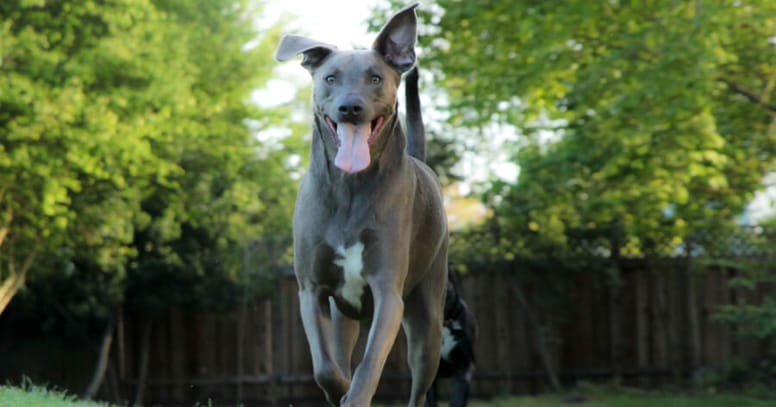
Also known as the "Lacy" or the "Lacy Dog", it first made its appearance in Texas in the United States during the 1800's. Blue Lacy purebred dogs make brilliant family pets and are fine with other dogs too. Always alert, attentive and will see any task through to the end.
Blue Lacy dogs are well-balanced dogs are of a medium size and are really eye-catching. Their appearance is always alert and with very smooth, short coats they are splendid dogs. Colourings are solid slate grey or tri-coloured which is blue with red markings on the legs, muzzle, and tail and above the eyes. A true beauty!
5. Neapolitan Mastiff
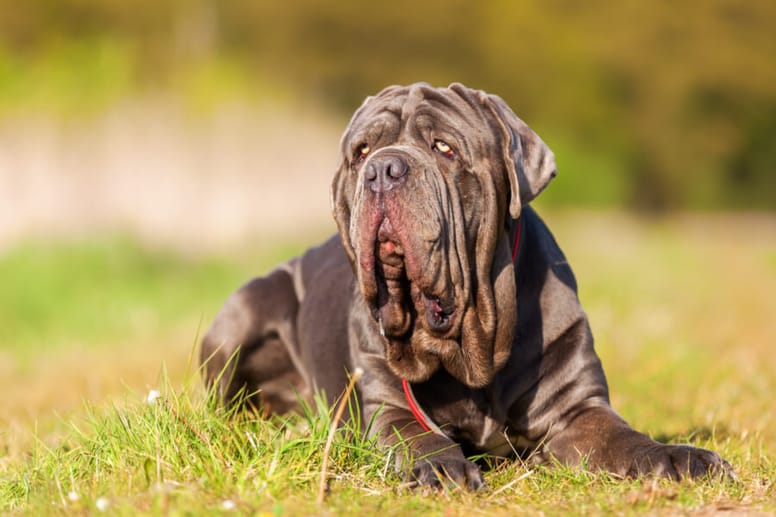
The Neapolitan Mastiff has a unique physique: droopy eyes, flabby jowls and a gigantic body. This dog breed is usually coated in one colour and blue is a popular shade among black and brown. If you wish to get a Neapolitan Mastiff it is important you take into account the size of this dog.
They are strong (adults can weigh up to 100 pounds) and will need a firm and positive training as these dogs were bred as guard dogs. Also, the rolls they have on their faces will have to be groomed properly. This dog breed is however a loving pup and an excellent companion.
6. Shar-Pei
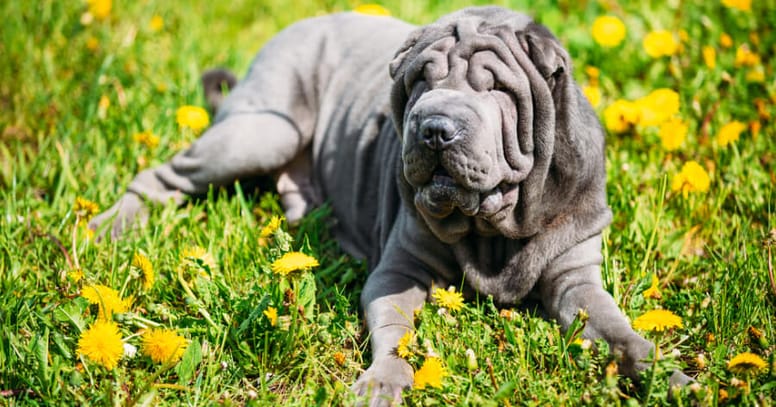
The Shar-Pei was Initially bred as a herding, hunting and guard dog. With a very protective nature, they devote themselves to the family to protect them against any threats. These medium-sized dogs are very intelligent but sometimes they can be quite stubborn. When training a Shar-Pei, the owner will need to be firm and consistent as this dog breed will challenge its owner sometimes.
Brown and red tones are most commonly seen on the Shar-Pei's coat colour but the blue colour is no rarity.
7. Irish Wolfhound

The tallest dog known to man! They make wonderful family pets, although they probably consume large amounts of food. Used largely for hunting but they also are tremendous guard dogs, purely because of their intimidating size.
These gentle giants date back to 7000BC. Later, during the 1500's in Ireland, only nobility was allowed to own an Irish wolfhound . His rough, wiry coat gives protection against the worst of the weather. IThis dog breed's coat colour comes in few colours and sometimes it can be difficutl to to tell the difference between grey, blue or silver. With a long tail and small ears, this is certainly a dog full of character.
8. American Staffordshire Terrier

The American Staffordshire Terrier also known as Staffies make amazing companions. This dog breed is not for everybody, we must admit.
Staffies are often misunderstood because of their reputation, and they will need a firm, positive and consistent training but also they will need to be socialised at an early age. Staffies, these loving dogs come in various coat colour, including blue. You will be able to find any shade of blue, from solid blue to blue brindles.
9. Chow-Chow

Chow-Chows are famous and loved for their fluffy, bear-like, physical characteristics. Although they tend to be very territorial and aloof pets, with the right owner they can be a perfect choice.
Originating from Nothern Asia, this pup is very loyal and makes an excellent guard dog. Although the Chow-Chows look like huge teddy bears, some of them can have an aggressive personality, therefore they will need to be socalised at an early age.
10. Great Dane
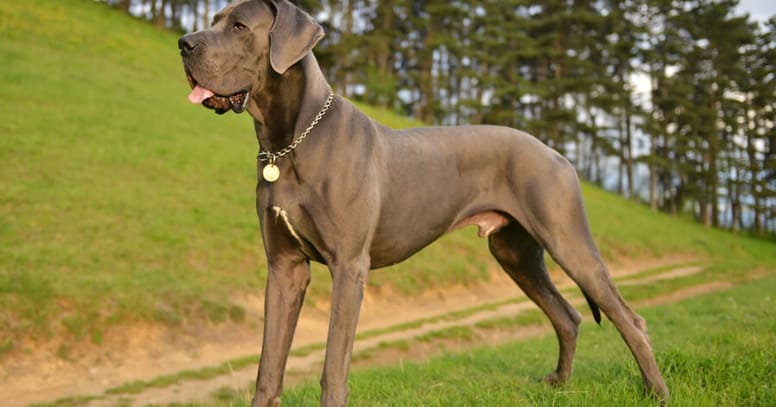
These giant gentle are unique and popular thanks to their physique. Did you know that the Great Dane was one of the largest dog breed in the world? Originating from Germany, they were used to hunt. With that being said, today, the Great Dane would be totally happy and content with just a few walks a day just to keep their energy buzzing.
When it comes to their coat patterns and colors, the Great Dane comes in different shades and blue is quite common. In fact, solid blue is one colour which is very popular. You can find blue brindle, harlequin or merle patterns on Great Danes.
What is blue dog color?
The colour blue for a dog are inherited in a different way depending on genetics. A dog can be born with a solid blue coat, or maybe with blue patterns that have been passed from the parent dog.
As a general rule, there are 4 different groups of a blue dog coat:
- Blue Merle: This is more of a pattern description than a full-colour block of blue. It appears as if the blue merle dog has a marbled effect coat. Sometimes these dogs have blue eyes, but always a black nose.
- Blue Tick: This shade actually appears as navy blue. However, it is due to a black coat over a white base with the mottled effect appearing as a blue colourway. The dogs will have a black nose.
- Blue with progressive silvering: These pups will be born black, but as they get older their coats change to blue-grey shading. They always have a black nose.
- Blue dilute: A canine group that are either dark brown over black in colour through inheritance. The coat colour actually appears to be a blue-grey colour. This dog normally has grey paw pads and a grey nose.
Are blue dogs unhealthy?
Blue dog breeds present with a reduction in normal skin colours in addition to the colour of several other body components.
They are more likely to have skin problems linked to colour dilution alopecia. This condition is also known as "blue Doberman syndrome" regardless of the fact that it certainly isn't linked just to the Dobermann breed. As a result of this alopecia, the dog can suffer from hair loss at the sites of the dilute-colour locations on the body. This usually happens at around 6 months, continuing to 3 years of age. Hair loss will be apparent along the back although it doesn't normally spread to the limbs, tail or head of the dog.
Other health issues affecting blue dog breeds are allergic skin reactions, wrinkled skin and dermatitis. Some pups are symptom-free yet develop them when older.
If you are choosing any breed or colour of dog for your new pet, it's super important that you do your research. This is even more so with a blue dog breed, that is known to suffer from specific genetic anomalies and possible health issues. Even so, these canines make wonderful companions.
Source: https://wamiz.co.uk/dog/advice/1020/10-blue-dog-breeds-that-you-will-love